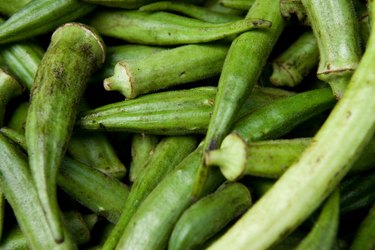 Choose Okra that has a firm skin and no blemishes if storing it through freezing.
Choose Okra that has a firm skin and no blemishes if storing it through freezing.
Okra, also called Ladies Fingers, is a staple vegetable in many South American and Asian cuisines, especially Indian. Begun in Egypt and initially cultivated there, the plant eventually spread over continents through trading and settlers. The plant is used in a variety of ways, from stews to braising it on its own. Okra can be used in a pickled form as an accompaniment to many dishes and is easily created at home. While fresh okra is optimal, frozen ones can be used as long as several aspects are taken in to account.
Selecting
Choose frozen okra that has not been previously blanched — this will create an extremely mushy texture when they are canned. Select each okra the same way you would when choosing fresh — no blemishes on the skin, and the outside should be smooth with no wrinkles and smaller, younger okra should be chosen.
Defrosting
The okra cannot be canned while it is still frozen for it will hinder any long-term canning and add unwanted water to both the short- and long-term canning methods. Place the okra in a colander over the kitchen sink and allow it to defrost slowly over an hour, tossing it on occasion to allow all the okra equal access to the air. Shake the colander slightly to remove all moisture, and cut them up as desired for pickling when completely defrosted.
Processing
Process the previously frozen okra the same way you would with the fresh. Place the okra in to the jar and add the white vinegar, pickling salt, minced garlic and whatever other seasonings and spices you desire, leaving 1-inch head space. If wanting to create short-term pickles, place the jar in the refrigerator and let them stew for four to five days, and then consume them within a week to two of creation. Process them in a hot water canner or pressure canner if desiring to keep them for a long period of time.
Texture
The texture of the canned frozen okra will differ on the fresh pickles. The canned vegetable will have more of a mushy texture, although it is completely safe, whereas fresh okra creates a crunchy pickle that is often desired. Take this in to account when using frozen okra to create pickles. The same requirements apply to the fresh as they do to the frozen — unblemished, firm and young.


